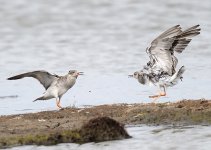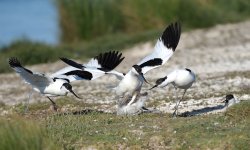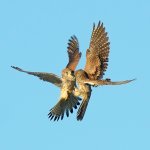-
Welcome to BirdForum, the internet's largest birding community with thousands of members from all over the world. The forums are dedicated to wild birds, birding, binoculars and equipment and all that goes with it.
Please register for an account to take part in the discussions in the forum, post your pictures in the gallery and more.
You are using an out of date browser. It may not display this or other websites correctly.
You should upgrade or use an alternative browser.
You should upgrade or use an alternative browser.
The D800 and the D800E (1 Viewer)
- Thread starter Jaff
- Start date
More options
Who Replied?Dave Williams
Well-known member
Can somebody give me a really good argument as to why anyone needs more than even 4 FPS for birding. I can understand for sports but why do you need more even for BIFs. Surely this is more down to technique and experience i.e. panning with bird etc.
Lots of instances as far as I'm concerned. Slow moving subjects might not be as critical but even then a slight turn of the head might make a difference in the way the light catches the eye. With fast moving subjects like a Kingfisher or a Gannet diving and hitting the water or appearing with their catch, an Osprey striking a fish, or an Heron striking it's prey it makes a huge difference between catching the action at the critical moment or being a little too soon or too late.
I see just as much need for faster frame rate in nature photography as in sport. cheers Dave
Helios
Well-known member
Action photography for wildlife happens in a blink of an eye, just as Wayne Rooney striking a ball or a knockout punch from a boxer. With a fast FPS camera with an adequate buffer, you can get a sequence of say 20 shots, rather than say 5 with a slower one. This can make all the difference to the end result as you'll get a better chance of catching the perfect action shot.
Some examples: -
Some examples: -
Attachments
Dave Williams
Well-known member
Why not buy a video !
Why not take up another hobby !
Seriously , part of the magic of still photography for me is capturing a moment that the eye and brain can't register as it happens too quickly.
One like this for example
http://www.birdforum.net/gallery/showphoto.php/photo/367230/ppuser/53820
You wouldn't see this on video no matter how slow it was replayed
cheers Dave
ericbowles
Well-known member
At a professional level or in major contests, the right head position or eye contact at critical action can make the difference between a good image and a winner. Head position and a catchlight are very important - even with critical action. Being able to fire a burst of 8 images in a second of action doubles the chance of a perfect capture.
I usually find that a short burst of 2-4 shots is plenty, but there are subjects and occasions where more really is better. You can develop an understanding of your subject and know whether you need short or long bursts of images. It also takes practice to be able to switch between short and long bursts of images.
I usually find that a short burst of 2-4 shots is plenty, but there are subjects and occasions where more really is better. You can develop an understanding of your subject and know whether you need short or long bursts of images. It also takes practice to be able to switch between short and long bursts of images.
Dave Williams
Well-known member
At a professional level or in major contests, the right head position or eye contact at critical action can make the difference between a good image and a winner.
At an amateur level and in minor contests it's exactly the same for me. We can all aspire to capture the ultimate image, it's when we stop dreaming that we have to query what we are doing ! cheers Dave
Why not buy a video !
Les,
I wonder how long before we are all shooting HD video at hi rez and "frame grabbing" for stills. For those who are happy with record shots at 1920x1080 we are already there. The Nikon V1 is shooting 60 frames in full Raw in one second. With 4K HD video the quality might be enough for most of us and Japanese Researchers are developing an 8k sensor.
Neil
Jaff
Registered Member
Yes you do. We're talking about what are semi-professional bodies here and many full time pros would probably want one too and indeed would have had a great deal of input as to what they want to see from these bodies. If you're needs out of photography don't match what cameras of this level and above deliver then the answer is simple, buy from the lower end like a D7000. The capabilities will always reflect the price so if you don't need a super low light camera or one with high end movie quality then you don't have to have one.
So what I'm getting at is these cameras are aimed at professional togs and they tell Nikon what they'd like to have in them, which is superb lowlight shooting and high quality movies and so Nikon produce cameras that deliver what this segment of the market wants to see.
So what I'm getting at is these cameras are aimed at professional togs and they tell Nikon what they'd like to have in them, which is superb lowlight shooting and high quality movies and so Nikon produce cameras that deliver what this segment of the market wants to see.
Steve Tucker
Well-known member
Can somebody give me a really good argument as to why anyone needs more than even 4 FPS for birding. I can understand for sports but why do you need more even for BIFs. Surely this is more down to technique and experience i.e. panning with bird etc.
Why not buy a video !
Are you saying I can't have a ff camera then, as only pros use them ?
Are you being deliberately pedantic?
GYRob
Well-known member
One thing that will always be the case if haveing to buy things on a camera we neither want or use .
Take the 7d my main camera i dont need P tv av or a popup flash i dont need auto iso or any iso above 1600 for that matter ,i dont need the level indicator or 90% of the custom fuctions ,i dont need a light in the LCD or AI focus and quite a few more things BUT the 7d has the things i do want 6fps spot focus point and fast and very good af plus af tracking control M and micro ajust and yes a few more bits .
So its just a case of buying a camera that does have what you want and forget about the bits that are there and you dont want.
Rob.
Take the 7d my main camera i dont need P tv av or a popup flash i dont need auto iso or any iso above 1600 for that matter ,i dont need the level indicator or 90% of the custom fuctions ,i dont need a light in the LCD or AI focus and quite a few more things BUT the 7d has the things i do want 6fps spot focus point and fast and very good af plus af tracking control M and micro ajust and yes a few more bits .
So its just a case of buying a camera that does have what you want and forget about the bits that are there and you dont want.
Rob.
To try and answer Les’s question, I do think that we are at the zenith of digital technology at the moment; in terms of cameras and how the images are reproduced we can’t get much better. It isn’t because we have not developed better, it just that each facet of the process has to play ‘catch-up’.
Camera manufacturers are looking for that edge, the image is pretty good at all levels, and they’re adding finery to the product to tempt us.
Macmillan stated in the 50’s that Britain never had it so good, well you can apply the same analysis to digital cameras. Out there in this big wide world there is a digital camera to suit all needs and all budgets.
The arguments about FPS, ISO, noise, filters, etc are meaningless, I’ve stated many times that the image you’re viewing on your monitor will bear little resemblance once it had gone through the reprographic process. How you perceive what skill level you are at is entirely down to your own perception.
Cutting through all the nonsense that has been written on the D800, there is one overriding fact for which there is no argument, and that’s the joy factor in owning a camera such as the D800.
If you can afford it without sending the wife, kids and those wretch guinea pigs that dig holes in the lawn into slavery, but keep the dog, because he’s really yours, then the sheer satisfaction really should suffice.
It isn’t perfect and will not suit a lot of people, but I can’t think of a camera that does cover all the requirements.
Camera manufacturers are looking for that edge, the image is pretty good at all levels, and they’re adding finery to the product to tempt us.
Macmillan stated in the 50’s that Britain never had it so good, well you can apply the same analysis to digital cameras. Out there in this big wide world there is a digital camera to suit all needs and all budgets.
The arguments about FPS, ISO, noise, filters, etc are meaningless, I’ve stated many times that the image you’re viewing on your monitor will bear little resemblance once it had gone through the reprographic process. How you perceive what skill level you are at is entirely down to your own perception.
Cutting through all the nonsense that has been written on the D800, there is one overriding fact for which there is no argument, and that’s the joy factor in owning a camera such as the D800.
If you can afford it without sending the wife, kids and those wretch guinea pigs that dig holes in the lawn into slavery, but keep the dog, because he’s really yours, then the sheer satisfaction really should suffice.
It isn’t perfect and will not suit a lot of people, but I can’t think of a camera that does cover all the requirements.
JPAC
Well-known member
Birding what if question?
D800, 1.2 crop = 25MP file, [L] 6144 × 4080 pixels (25.07 megapixels) jpeg plus NEF RAW available, five fps, 1.2 crop = 20% increase in focal length ~ 500mm becomes 600mm equivalent. 10MP more than DX setting.
Enough data for a great A3+ inkjet ~ 19" or double page magazine print, saves 11MP in storage per shot, quicker computer processing, NEF file for tweaking after the shot
What am I missing?
D800, 1.2 crop = 25MP file, [L] 6144 × 4080 pixels (25.07 megapixels) jpeg plus NEF RAW available, five fps, 1.2 crop = 20% increase in focal length ~ 500mm becomes 600mm equivalent. 10MP more than DX setting.
Enough data for a great A3+ inkjet ~ 19" or double page magazine print, saves 11MP in storage per shot, quicker computer processing, NEF file for tweaking after the shot
What am I missing?
ericbowles
Well-known member
Birding what if question?
D800, 1.2 crop = 25MP file, [L] 6144 × 4080 pixels (25.07 megapixels) jpeg plus NEF RAW available, five fps, 1.2 crop = 20% increase in focal length ~ 500mm becomes 600mm equivalent. 10MP more than DX setting.
Enough data for a great A3+ inkjet ~ 19" or double page magazine print, saves 11MP in storage per shot, quicker computer processing, NEF file for tweaking after the shot
What am I missing?
I think in general you are correct. You need to be careful because I think you are confusing megapixels with megabytes. The image size is certainly smaller, but I have heard conflicting information on the resulting size of the file. The standard RAW file is 75 MB - roughly three times the size of the D700/D3/D300. I've seen information that the RAW file is smaller with some crops, but I have not seen confirmation that applies to all in camera cropped images.
In terms of quality, all that is happening is you are cropping the 36 mp image to a smaller size. Today you can crop it even smaller by using the 16 mp D7000. Pixels are the same size on the D7000 and D800 - you just have more area covered with additional pixels.
Your reference to 20% more focal length is a bit misleading - it's just a crop so that the field of view is equivalent to a longer focal length. Now as you point out, the quality of the image is just fine for A3 or magazine work.
My take is we will need to think about final output at the point of capture. For many situations, in camera JPEG's or cropped images are just fine. You might as well crop in the camera with distant subjects if you are going to be cropping anyway. And the same with JPEG's - if you intend to not post process individual images from events, sports, or even bird identification shots, why not shoot JPEG.
JPAC
Well-known member
JPEGs are fine most of the time if you get all the settings you want sorted before each shot, with RAW you can tweak sharpness settings etc after the shot.
Using the full 36MP fills up the memory card and hard drive quicker, the D800 loses one fps and the file size saving will be much more than I thought. My 11MP should of course be 11MB not 11MP. 36-25MB = 11MB saved every photo. All this is irrelevant if you cannot get close enough to the bird of course, ie filling the frame. Using the full 36MP to make a small print at high dpi just wastes more ink IMO. I read most people cannot see the difference between 240dpi and 360 dpi anyway.
25MP would be more than enough for me and 36MP is way too much for A3+ inkjet, ideally I would have liked 18MP. There's no smaller RAW output at M jpeg setting on the D800, just shrinks the jpeg file size. Selecting RAW + jpeg M will result in a M jpeg but a 36MP RAW file.
RAW file sizes are on the chart I posted earlier and on Rob Galbraith's D800 page for the crops.
So, what I'm looking for is a good compromise really.
Using the full 36MP fills up the memory card and hard drive quicker, the D800 loses one fps and the file size saving will be much more than I thought. My 11MP should of course be 11MB not 11MP. 36-25MB = 11MB saved every photo. All this is irrelevant if you cannot get close enough to the bird of course, ie filling the frame. Using the full 36MP to make a small print at high dpi just wastes more ink IMO. I read most people cannot see the difference between 240dpi and 360 dpi anyway.
25MP would be more than enough for me and 36MP is way too much for A3+ inkjet, ideally I would have liked 18MP. There's no smaller RAW output at M jpeg setting on the D800, just shrinks the jpeg file size. Selecting RAW + jpeg M will result in a M jpeg but a 36MP RAW file.
RAW file sizes are on the chart I posted earlier and on Rob Galbraith's D800 page for the crops.
So, what I'm looking for is a good compromise really.
Users who are viewing this thread
Total: 2 (members: 0, guests: 2)






